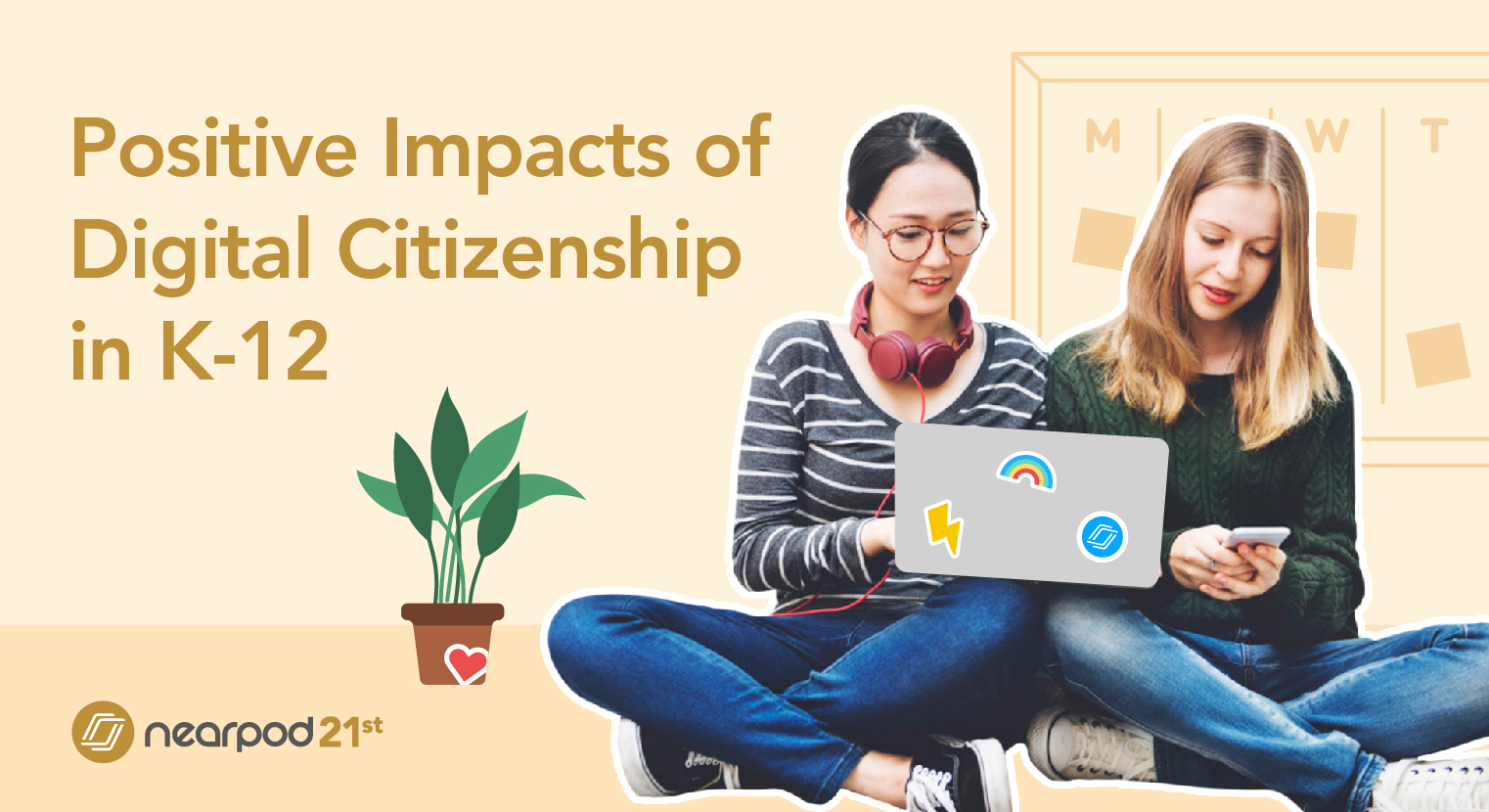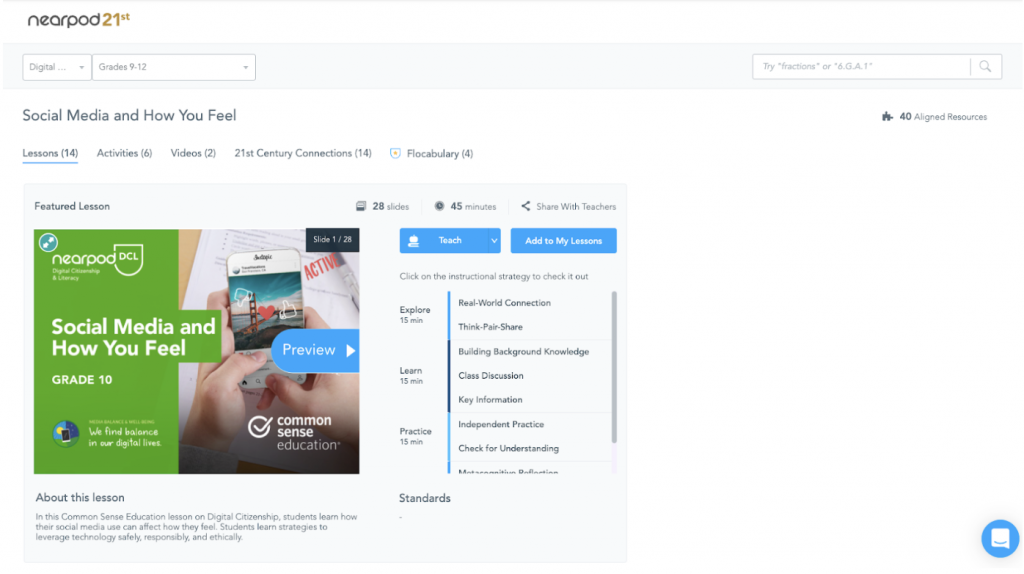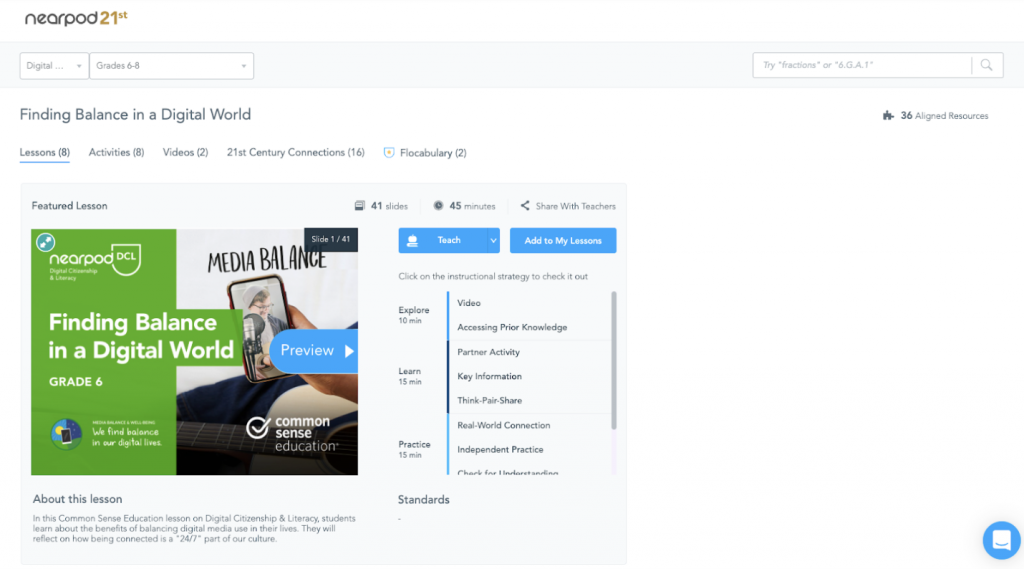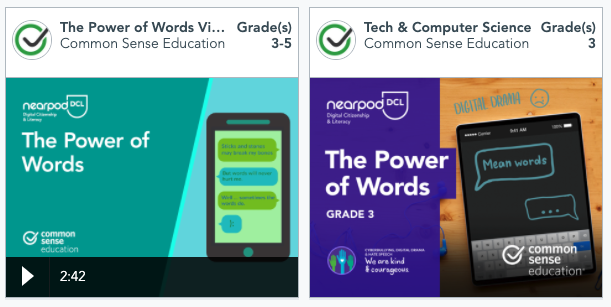
The positive impact of digital citizenship instruction in K-12
Learn how these teachers and administrators are helping students become safe and responsible digital citizens and impacting their school culture. They’re using resources from Nearpod & Common Sense Education’s Digital Citizenship curriculum available in Nearpod’s 21st Century Readiness Program.
Julia Maynard
6th-grade teacher, Willie Brown Middle School, San Francisco Unified School District, San Francisco, CA
Julia Maynard is a sixth-grade teacher at Willie Brown Middle School in the Bayview neighborhood of San Francisco. She has been teaching middle school for 10 years as an English, history, and humanities teacher. She currently teaches history and a technology class.
Keep reading to learn from Julia how digital citizenship impacted her classroom.
Background
Willie Brown Middle School is a brand new school in the Bayview community in San Francisco. Last year was our first year of operation, and we have students coming from several elementary schools in the city, so there are a lot of kids coming together from different neighborhoods around San Francisco. The Bayview community is traditionally an underserved population, so we’re working hard to build community and focus on building not only academic skills but also social-emotional learning and healthy lifestyles. Nearpod and the digital citizenship curriculum fit nicely with what we are trying to do at our new school.
My favorite thing about teaching is the “aha moment” that happens when you have a kid who is struggling, he or she doesn’t totally understand a concept, then suddenly they “get it.” They can explain it, they’re visibly excited to share their learning, they look and act confident, and look forward to sharing their new knowledge or skill with me and their classmates.
Overcoming challenges with online behavior
Most adults don’t know how to protect themselves online, and we’re expected to teach the principles of online safety and responsibility to our students. It’s not something most teachers grew up with, and it’s also something that parents oftentimes don’t know how to talk to kids about. My kids posted inappropriate things on Instagram, students made fake accounts, and unfortunately, students shared inappropriate pictures and texts with each other. They didn’t realize that what they send can’t be taken back and can be hurtful to their classmates. It was a big problem in the school last year, and this year the digital citizenship curriculum has helped our students think about these issues in a new way.
Additionally, as many middle school teachers know, students can sometimes be mean to each other. They’re not sure how to relate to each other, and when they don’t have face-to-face interaction, it’s a lot easier to be mean. Kids don’t really think about their actions online the same way they think about their actions in person, and this curriculum has helped bridge that gap.
In general, the most challenging part of my job is finding ways to get kids engaged and keep them motivated to learn. Finding things that pique their interest while trying to compete with cellphones and video games is a challenging task. Most of my students come to school with devices that are unlocked and interconnected, yet we (school staff) expect them to do exactly what we want them to do, not what they normally do when they have those devices.
How I use Nearpod to teach digital citizenship
I’ve used Nearpod for a long time and was excited when we found out that we had access to extra features and curriculum through the SFUSD license. Nearpod is awesome because it delivers the lesson to the student’s hands. I don’t have to worry about the kids who are sitting in the back or kids who are shy, everyone is on the same playing field. There’s instant engagement when kids can share their work, I can share their answers back to the class, and I can poll the class to see how they’re feeling. All of the kids answer all of the questions, and I get to see what they know and how they’re progressing with new information in real time.
Digital citizenship is such an important topic to cover with students, and with Nearpod, it’s easy to teach. The Nearpod and Common Sense Digital Citizenship lessons that come with the 21st Century Readiness Program are high-quality resources. There are a lot of topics that I wouldn’t have thought to discuss with my students, but the curriculum is comprehensive. On Nearpod, the lessons are great because I can download, review, and teach immediately! There’s minimal prep work, I don’t have to spend a lot of time researching and curating resources, and the lessons are easy to use with students. Additionally, kids have multiple ways to answer questions and demonstrate an understanding of key concepts.
Building a positive community through digital citizenship
“We continue to teach even more digital citizenship lessons because it’s a great way to build a positive community.”
Julia Maynard
One of the things that surprised me about this curriculum was the strong community-building aspect. Not simply building a digital community, but building community in the classroom, too. We continue to teach even more digital citizenship lessons because it’s a great way to build a positive community. We have a brand-new school, so at the same time we’re building a curriculum for the year, we’re building school culture and community, too. Finding ways to facilitate serious conversations has made a noticeable difference in how my kids talk to and interact with each other.
Alex Springer-Post
K-5 Instructional Technology Coach, Seldens Landing Elementary School, Loudoun County, Virginia
Alex is a K-5 instructional technology coach in Loudoun County Public Schools in Virginia. She previously taught in North Carolina and West Virginia, where she was the first teacher in a computer lab at her school.
Keep reading to learn what Alex has to say about teaching digital citizenship.
Background
A few years ago, I became the first technology resource teacher in a computer lab in a West Virginia middle school. I began to build my online community and find effective edtech resources and strategies, so I attended my first education technology conference, where someone introduced me to Nearpod. At the time, I was looking for resources to create hands-on coding lessons. Nearpod was a great fit, so I started using Nearpod by adapting code.org lessons to Nearpod for my class. When I moved to Virginia, I took on a new role as an instructional technology coach because I have always loved using technology in the classroom and I wanted to share the techniques and strategies that helped me engage my students with other teachers.
Teaching my students the importance of digital citizenship
Our students are on the internet every day. When I talk to younger students, even my K-2 students, they’re playing games, and a lot of games have the ability to chat. I asked my second graders “have you seen anyone write a mean comment to someone else online?” Unfortunately, I’ve started to skip over that question, because the answer is nearly 100% yes. Some of them were scared, some of them don’t know what to do in that situation, and they don’t want to tell their parents because oftentimes they’ll lose their devices.
The concept of a “digital footprint” is great to introduce younger students to because many of them already share their words online and are leaving a footprint behind. It may not be attached to them because they usually don’t share their private information, but they have to know that future employers, colleagues, friends, and loved ones have the ability to find things you said or did when you were younger, and what they do or say now has the ability to impact their future.
How I use Nearpod to teach digital citizenship
Before I used the Nearpod & Common Sense curriculum, I had students sit in a circle on the floor to complete pencil and paper digital citizenship activities and a few students raised their hands to add to the discussion. With Nearpod, more kids participate and more of them feel comfortable contributing to the lesson.
There’s safety in Nearpod, and my class has been impacted in a positive way. I have a student with selective mutism who can now participate and share his thoughts in the lesson! I share student responses, but I keep the responses anonymous, so we’re able to stay on topic and keep the discussion focused. Lots of students are excited when I share their answers so they aren’t afraid to take credit. In my classroom, I set the expectation that students don’t call each other out, and Nearpod helps to encourage that expectation.
When we’re dealing with topics like media literacy, digital drama, self-identity, and cyberbullying, Nearpod is especially helpful because students are more comfortable sharing answers that are personal or scary to them. My students don’t have to raise their hands and broadcast their answers to everybody, but they also don’t have to search for me afterward if they need to explain something. They can share their thoughts and feelings without feeling self-conscious. Some of the topics are especially sensitive because kids don’t want to seem “uncool,” admit that they were hurt, or that someone made fun of them.
The student impact of teaching digital citizenship
In my 5th grade class, we completed a “Power of Words” lesson, and it was interesting to see the way students reacted to cyberbullying and the difference between each class. I had one class last year that was a challenging group. In one of the Digital Citizenship lessons, students were asked to agree or disagree with the statement “sticks and stones may break your bones but words will never hurt me.” 65% of the class thought that this was a true statement, and many of these kids had no idea the impact their words could have on others!
“No one wanted the lesson to end. When it was over, many questioned “class is over already!?” How often does that happen as a teacher?”
Alex Springer-Post
It sparked an interesting and productive conversation, and also enlightened the rest of my colleagues about the importance of being attentive and intentional regarding students’ choice of language. Our class discussion about the impact words can have on others hit home with many students, who realized that they have been hurt by the words of others, and then made the connection to what they were saying and posting online. The connections they were making between in-person and online interactions were so productive for how they treated each other moving forward.
No one wanted the lesson to end. When it was over, many questioned “class is over already!?” How often does that happen as a teacher? After my students left class, they treated each other with a higher level of respect, and they were more likely to take each other’s feelings into consideration when choosing what to say online or off.
Learn how to bring Nearpod’s 21st Century Readiness Program to your school or district!
Amy Klabunde
School technology lead & computer lab teacher, Baltimore City Public Schools
Amy is a 15-year veteran educator in Baltimore City Public Schools. She is currently a school technology leader and a computer lab teacher for a Title 1 school in Baltimore.
Keep reading to learn how Amy used Nearpod to teach digital citizenship.
Background
My school has a population of 468 students and we’re a 100% free and reduced lunch school in Baltimore City, so our resources are low. I began my career as a music teacher 15 years ago, and technology is something that I’ve always loved and incorporated into my classroom. Three years ago I was part of a pilot program in Baltimore City Public Schools to be a tech leader. I was interested in teaching with technology and teaching students about technology, so I became the tech guru at my building, which inspired my principal to start a technology class. We have one computer lab with 30 computers and we have one working laptop cart.
How I use Nearpod to teach digital citizenship
With the digital citizenship curriculum, I rarely need to supplement or modify the lessons. Even for my eighth graders who often think they’re “too cool for school,” they get excited about the next activity in the lesson, they look forward to learning the key concepts, and they’re excited about how much they get to participate and voice their opinion. Before I found the Nearpod & Common Sense digital citizenship curriculum it took me at least an hour to plan for each digital citizenship lesson because I had to make sure every website worked, think through the flow and timing of the lesson, and build in procedural time for directing students to online resources. But with the Nearpod and Common Sense curriculum, everything is packaged together, and it’s easy for my kids to understand. The curriculum developers definitely understand how to be age-appropriate and sensitive to the developmental stages of my students.
Leveraging student-paced Nearpod digital citizenship lessons
A lot of the curriculum in my technology class is related to digital citizenship. My district wants our kids to understand that the Internet can be very helpful, but it’s a place where they have to be thoughtful, careful, and responsible. Nearpod’s student-paced option for teaching digital citizenship lessons is amazing, especially because I teach students who have vastly different reading levels and writing skills. Initially, with the live participation option, it was challenging to keep everyone on the same page. Now students can complete activities at a pace where they feel comfortable. Other students can take extra time and ask clarifying questions, while the rest of the class can progress without frustration or too much idle time. The student-paced option has made this school year so much better because my kids feel more in control of their learning.
Digital Footprint lessons
With the Nearpod and Common Sense digital citizenship curriculum, I’ve seen a lot of changes in my students. The curriculum itself encourages students to think about their presence on the internet. I recently completed the “Who’s Looking at Your Digital Footprint?” lesson with my 8th graders. We started the lesson with the prompt “Google your name and see what appears.” Some of the students were very upset about what they found publicly available about themselves. They asked “Why did my Facebook page pop up? Why did my Twitter profile pop up? Anyone can see this?!” Many were not aware of privacy settings or what data could be accessed by billions of people around the world on the internet.
Before I led the digital footprint lesson, a lot of my students didn’t understand what it meant to have a digital footprint. They didn’t grasp that their comments, posts, and pictures on the Internet could last forever. The curriculum is great because it makes kids think and reflect on their actions online and offline. During the digital footprint lesson, students reflected on the question “Am I the person I see on the Internet when I google my name? Is this how I want to present myself to the world?”
After the lesson, my students began to understand that there’s a difference between making themselves look “cool” and purposefully sharing what they post on the internet. That made me happy because a lot of kids think that the purpose of Facebook and Instagram is to show off and put on a facade, but that’s not necessarily the best representation of themselves.
The next step for my class was to create a “digital footprint”, where we each made a physical footprint that doubled as an infographic to hang outside of my classroom. The footprint included how my kids wanted to represent themselves to others online.
Reducing cyberbullying
We had cyberbullying occur a lot last year. Kids wrote negative comments about other students online and thought it was private or that teachers and parents wouldn’t discover it. The cyberbullying spilled into the school building, causing fights in the hallway after school. When we investigated what caused the problems, it often stemmed from comments or posts on social media.
“A lot of our social media drama has declined since we made an effort to teach digital citizenship.”
Amy Klabunde
Once we discussed the specifics of cyberbullying, digital identity, and digital footprint, my students realized that their words online could have a negative impact on their classmates, they understood the permanence of their comments and built up empathy for what it would be like on the other side of the bullying situation. Having these conversations as a class has made a big difference in how the kids think and act when they’re online.

Impact on school culture
Discussing digital citizenship makes our lives as teachers a lot less complicated as we’re not trying to mediate issues that we don’t even know about. We’re not friends with our kids on Facebook or Snapchat, so we don’t know about problems that start online, and we’re taken by surprise when the problems enter the building.
“Online issues have not spilled over into the school building this year, which creates a safer environment for our kids.”
Since we’re now proactive about these topics, kids can identify and solve problems online before they escalate. Now, it’s impossible to know if all of the students are behaving appropriately online all the time, but online issues have not spilled over into the school building this year, which creates a safer environment for our kids. Teaching digital citizenship on Nearpod makes my students feel like they can express themselves honestly and not feel embarrassed or scared of the reactions of others. That makes Nearpod lessons much more powerful than using paper-based lessons because the kids have an added sense of security to be themselves because their answers will be shared anonymously.
Learn how to bring Nearpod’s 21st Century Readiness Program to your school or district!
Harmony Cano
Educational technology coach. Pasadena Unified School District, Pasadena, CA.
Harmony is one of two education technology coaches in Pasadena Unified School District, serving 30 school sites and 1000+ teachers across the district. She previously taught middle school social studies and ELA in Pasadena.
Keep reading to learn about the impact digital citizenship instruction had on Harmony’s students.
Background
I’m one of two education technology coaches in Pasadena Unified School District. My colleague and I help 1000+ teachers at 30 school sites with classroom technology integration. Since we have so many school sites and there are only two of us in the district, it’s challenging to get out to all the sites to create a curriculum and assist with hands-on technology integration. We used Common Sense Digital Citizenship curriculum before we used the Nearpod & Common Sense curriculum. Before the Nearpod curriculum launched, it was overwhelming for teachers to use the curriculum and challenging for us to coordinate. Common Sense & Nearpod’s partnership has been a huge asset to our district.
District-wide benefits of using Nearpod & Common SenseThe curriculum is delivered in a way that’s student and teacher-friendly. There is minimal prep time for teachers, the lesson plans are easy to follow, teachers can preview the lessons, and there are interactive activities and links to other resources that teachers can use.
It has made life easier for everyone, and the digital citizenship roll-out in our district has been a success. The way this curriculum is built makes it easy for everyone involved.
Harmony Cano
The Nearpod platform has helped our small technology team deploy digital citizenship lessons to teachers around the district, whereas beforehand, distributing the lessons to 1000+ teachers every year was a difficult task! With this curriculum, it was easy to build a library of digital citizenship lessons in our district Nearpod account where teachers accessed and downloaded the lessons in a ready-to-teach format. Additionally, we now have reports in Nearpod that we can send to the state, and Nearpod has helped tremendously with the paperwork we have to complete for e-rate compliance.
Efficient lesson prep
The teachers’ favorite aspect of the lessons is how age-appropriate they are. Teachers don’t have to plan the lessons and consider how to approach the principles of digital citizenship for different age groups. The students are really engaged, and developmentally the lessons catch the students’ attention. They can easily access and interact with the curriculum, and they feel like they’re learning from their peers because there are videos from kids their age, and teachers can easily share responses from their classmates. We love the curriculum, and we’re excited and blessed to have it. I look forward to continuing to use this great resource from Nearpod & Common Sense!
Learn how to bring Nearpod’s 21st Century Readiness Program to your school or district!

Nearpod’s award-winning platform is used by thousands of schools around the globe, transforming classroom engagement.












